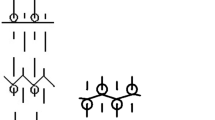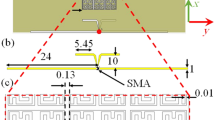Abstract
The growing development of telecommunications, especially mobile telecommunications, has intensified research into microfiber antennas in the last years, since these have unique properties as well as a wide range of applications. The research in the field of wearable technology is impelled by the demand for increasingly light and flexible devices, where electronic components are entirely embedded in their textile structures. The knitted fabrics have the necessary elasticity to create adaptive and sporty pieces, allowing high mobility and comfort to its users. The concept of textile antennas is based on malleability and, for this reason, they can have great utility in applications where the stiffness of traditional antennas is considered a limitation, especially in military or biomedical garments. This study aims to determine the properties of the natural and synthetic fibers knitted fabric for use in microwave devices, presenting the materials and methods used in the research to the prototyping and simulation of a microstrip antenna. Four knitted fabrics with different structures (Jersey and Simple Piquet) and fiber compositions (Cotton and Cotton with Polyamide) were selected. The determination of the electrical properties was performed through the coaxial probe method to obtain the permittivity and tangent loss properties, and the determination of the physical properties according to the technical standards, where the textile properties (weight, dimensional stability, yarn count and tensile strength) of the analyzed samples were determined. The results were analyzed according to the proposed application and the CO_Piquet presented the lower loss tangent and better dimensional stability, the microstrip antenna was dimensioned to a frequency of 2.45 GHz according to the transmission line and resonant cavity method, and simulated in the HFSS where loss return, radiation diagrams and current density parameters was obtained.
Similar content being viewed by others
References
S. Subramaniam, S. Dhar, K. Patra, B. Gupta, L. Osman, K. Zeouga, and A. Gharsallah, IEEE Ant. and Prop. Soc. Int. Symposium, pp.309–310, 2014.
R. E. Iglesias, I. G. GAllego, L. I. Sanchez, and O. Quevedo-Teruel, IEEE Trans. on Ant. and Propagation, 62, 3873 (2013).
N. F. A. Elias, N. A. Samsuri, M. K. A. Rahim, N. Othman, and M. E. Jalil, IEEE Asia-Pac. Conf. on Appl. Electromagnetics, pp.132–136, 2012.
S. J. Boyes, P. J. Soh, Y. Huang, G. A. E. Vandenbosch, and N. Khiabani, IET Microwaves, Anten. & Propagation, 6, 1696 (2012).
J. J. Lilja, P. Salonen, T. Kaija, and P. de Maagt, IEEE Trans. on Ant. and Propagation, 60, 4130 (2012).
A. J. S. Ferreira, F. B. N. Ferreira, and F. R. Oliveira, Redige, 5, 1 (2014).
C. Hertleer, A. V. Laere, H. Rogier, and L. V. Langenhove, Text. Res. J., 80, 177 (2010).
J. Virkki, T. Björninen, S. Merilampi, L. Sydänheimo, and L. Ukkonen, Text. Res. J., 85, 294 (2015).
E. G. Lim, Z. Wang, J. C. Wang, M. Leach, R. Zhou, C. Lei, and K. L. Man, Eng. Lett., 22, 1 (2014).
C. Hertleer, A. Tronquo, H. Rogier, and L. V. Langenhove, Text. Res. J., 78, 651 (2008).
C. Lin and K. Ito, Electronics, 3, 398 (2014).
A. Tsolis, W. G. Whittow, A. A. Alexandridis, and J. C. Vardaxoglou, Electronics, 3, 314 (2014).
M. S. Aquino, Doctor Thesis, UFRN, Natal, Brazil, 2012.
N. O. L. Filho, Ph.D. Dissertation, University of Minho, Guimarães, Portugal, 2009.
Textilegence, International Textil Manufacturers Federation, Global Yarn and Fabric Output Increased, Istanbul. https://doi.org/www.textilegence.com/en/itmf-global-yarn-and-fabric-output-increased/ (Accessed April 10, 2018).
D. M. Pozar, “Microwave Engineering”, 4th ed., pp.1–756, John Wiley & Sons, New Jersey, 2011.
C. A. Balanis, “Antenna Theory: Analysis and Design”, 3th ed., pp.1–1096, Wiley-Ieee Press, New Jersey, 2005.
Acknowledgments
The authors thank those responsible for laboratories LAPCOM, from Department of Electrical Engineering, and LABCTEX from the Department of Textile Engineering, Federal University of Rio Grande do Norte (UFRN).
Author information
Authors and Affiliations
Corresponding author
Rights and permissions
About this article
Cite this article
Aquino, M.S., Holanda, S.M., Santos, T.F. et al. Analysis of Polymeric Knitted Fabrics on Properties for Telecommunications Devices Application. Fibers Polym 20, 2348–2354 (2019). https://doi.org/10.1007/s12221-019-8724-3
Received:
Revised:
Accepted:
Published:
Issue Date:
DOI: https://doi.org/10.1007/s12221-019-8724-3




